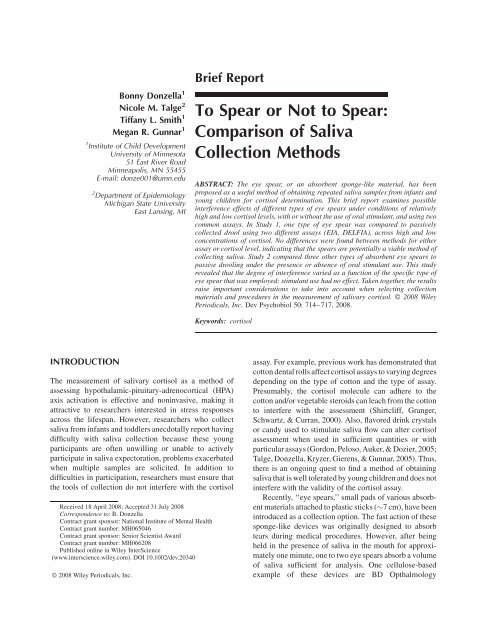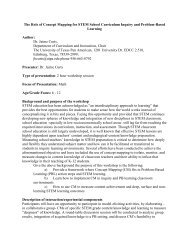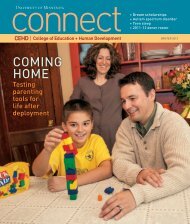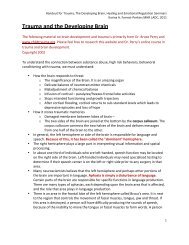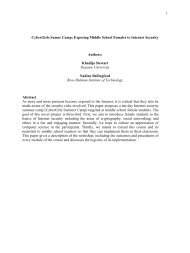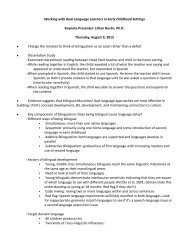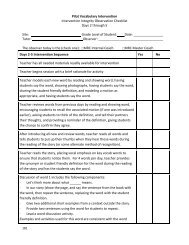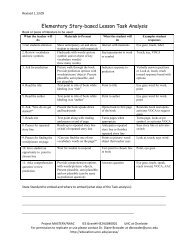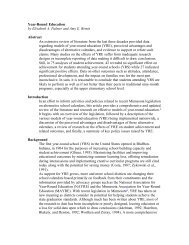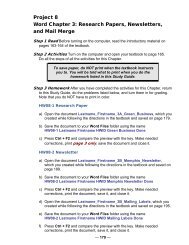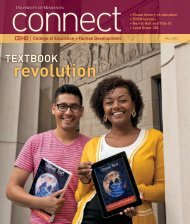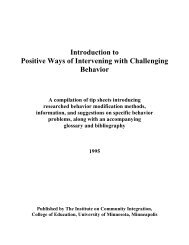Donzella, B. - University of Minnesota
Donzella, B. - University of Minnesota
Donzella, B. - University of Minnesota
You also want an ePaper? Increase the reach of your titles
YUMPU automatically turns print PDFs into web optimized ePapers that Google loves.
INTRODUCTION<br />
Bonny <strong>Donzella</strong> 1<br />
Nicole M. Talge 2<br />
Tiffany L. Smith 1<br />
Megan R. Gunnar 1<br />
1 Institute <strong>of</strong> Child Development<br />
<strong>University</strong> <strong>of</strong> <strong>Minnesota</strong><br />
51 East River Road<br />
Minneapolis, MN 55455<br />
E-mail: donze001@umn.edu<br />
2 Department <strong>of</strong> Epidemiology<br />
Michigan State <strong>University</strong><br />
East Lansing, MI<br />
Brief Report<br />
To Spear or Not to Spear:<br />
Comparison <strong>of</strong> Saliva<br />
Collection Methods<br />
ABSTRACT: The eye spear, or an absorbent sponge-like material, has been<br />
proposed as a useful method <strong>of</strong> obtaining repeated saliva samples from infants and<br />
young children for cortisol determination. This brief report examines possible<br />
interference effects <strong>of</strong> different types <strong>of</strong> eye spears under conditions <strong>of</strong> relatively<br />
high and low cortisol levels, with or without the use <strong>of</strong> oral stimulant, and using two<br />
common assays. In Study 1, one type <strong>of</strong> eye spear was compared to passively<br />
collected drool using two different assays (EIA, DELFIA), across high and low<br />
concentrations <strong>of</strong> cortisol. No differences were found between methods for either<br />
assay or cortisol level, indicating that the spears are potentially a viable method <strong>of</strong><br />
collecting saliva. Study 2 compared three other types <strong>of</strong> absorbent eye spears to<br />
passive drooling under the presence or absence <strong>of</strong> oral stimulant use. This study<br />
revealed that the degree <strong>of</strong> interference varied as a function <strong>of</strong> the specific type <strong>of</strong><br />
eye spear that was employed; stimulant use had no effect. Taken together, the results<br />
raise important considerations to take into account when selecting collection<br />
materials and procedures in the measurement <strong>of</strong> salivary cortisol. ß 2008 Wiley<br />
Periodicals, Inc. Dev Psychobiol 50: 714–717, 2008.<br />
Keywords: cortisol<br />
The measurement <strong>of</strong> salivary cortisol as a method <strong>of</strong><br />
assessing hypothalamic-pituitary-adrenocortical (HPA)<br />
axis activation is effective and noninvasive, making it<br />
attractive to researchers interested in stress responses<br />
across the lifespan. However, researchers who collect<br />
saliva from infants and toddlers anecdotally report having<br />
difficulty with saliva collection because these young<br />
participants are <strong>of</strong>ten unwilling or unable to actively<br />
participate in saliva expectoration, problems exacerbated<br />
when multiple samples are solicited. In addition to<br />
difficulties in participation, researchers must ensure that<br />
the tools <strong>of</strong> collection do not interfere with the cortisol<br />
Received 18 April 2008; Accepted 31 July 2008<br />
Correspondence to: B. <strong>Donzella</strong><br />
Contract grant sponsor: National Institute <strong>of</strong> Mental Health<br />
Contract grant number: MH065046<br />
Contract grant sponsor: Senior Scientist Award<br />
Contract grant number: MH066208<br />
Published online in Wiley InterScience<br />
(www.interscience.wiley.com). DOI 10.1002/dev.20340<br />
ß 2008 Wiley Periodicals, Inc.<br />
assay. For example, previous work has demonstrated that<br />
cotton dental rolls affect cortisol assays to varying degrees<br />
depending on the type <strong>of</strong> cotton and the type <strong>of</strong> assay.<br />
Presumably, the cortisol molecule can adhere to the<br />
cotton and/or vegetable steroids can leach from the cotton<br />
to interfere with the assessment (Shirtcliff, Granger,<br />
Schwartz, & Curran, 2000). Also, flavored drink crystals<br />
or candy used to stimulate saliva flow can alter cortisol<br />
assessment when used in sufficient quantities or with<br />
particular assays (Gordon, Peloso, Auker, & Dozier, 2005;<br />
Talge, <strong>Donzella</strong>, Kryzer, Gierens, & Gunnar, 2005). Thus,<br />
there is an ongoing quest to find a method <strong>of</strong> obtaining<br />
saliva that is well tolerated by young children and does not<br />
interfere with the validity <strong>of</strong> the cortisol assay.<br />
Recently, ‘‘eye spears,’’ small pads <strong>of</strong> various absorbent<br />
materials attached to plastic sticks ( 7 cm), have been<br />
introduced as a collection option. The fast action <strong>of</strong> these<br />
sponge-like devices was originally designed to absorb<br />
tears during medical procedures. However, after being<br />
held in the presence <strong>of</strong> saliva in the mouth for approximately<br />
one minute, one to two eye spears absorb a volume<br />
<strong>of</strong> saliva sufficient for analysis. One cellulose-based<br />
example <strong>of</strong> these devices are BD Opthalmology
Developmental Psychobiology<br />
‘‘Visispears’’ (product #581089), marketed by Salimetrics<br />
as ‘‘Sorbettes’’ (product #5029). de Weerth, Jansen,<br />
Vos, Maitimu, and Lentjes (2007) found that these devices<br />
have adequate cortisol recovery when samples are assayed<br />
using an in-house radioimmunoassay.<br />
The goal <strong>of</strong> this brief report is to describe two<br />
methodological studies that examined whether the use<br />
<strong>of</strong> eye spears interfered with salivary cortisol determination<br />
using assays and stimulant conditions that mirror<br />
those used in studies <strong>of</strong> infants and young children.<br />
METHOD<br />
Study 1: Viability <strong>of</strong> the Sorbette Eye Spear Under<br />
Two Assay Methods<br />
This study examined the use <strong>of</strong> Sorbette eye spears as a<br />
collection technique using either an enzyme immunoassay (EIA)<br />
or dissociation enhanced lanthanide fluoroimmunoassay (DEL-<br />
FIA) assay. Two pools <strong>of</strong> approximately 60 ml <strong>of</strong> saliva were<br />
obtained by combining 2 ml samples provided by laboratory<br />
staff either within 10 min <strong>of</strong> morning awakening (AM pool) or<br />
between 8 and 9 pm (PM pool). Early morning and late evening<br />
collections were used to allow testing <strong>of</strong> Sorbette eye spear assay<br />
interference at both high (AM) and low (PM) cortisol<br />
concentrations. Some volunteers provided only a morning or<br />
evening sample, and some provided both; as a result, time <strong>of</strong> day<br />
was not amenable to a within-subjects analysis. This guided our<br />
decision to pool the samples within time <strong>of</strong> day to form uniform<br />
high or low cortisol pools. After thorough mixing, each saliva<br />
pool was aliquoted into 120 samples. Samples were refrigerated<br />
for approximately 2 weeks prior to being assayed. Studies attest<br />
to the stability <strong>of</strong> the cortisol molecule, with levels remaining<br />
unaffected following several days <strong>of</strong> no refrigeration (Clements<br />
& Parker, 1998). Thus, we believe our storage procedure did not<br />
compromise the validity <strong>of</strong> our findings.<br />
Half <strong>of</strong> the samples from each 2(AM/PM) by 2 (speared,<br />
clear) group were then assayed in either the EIA method used<br />
in the assay kit sold by Salimetrics and the DELFIA method<br />
used by the Biochemisches Labor at the Universitaet Trier.<br />
One evening DELFIA sample was lost to error. Assays were<br />
performed in duplicate, with duplicates within 10% <strong>of</strong> each<br />
other. Inter- and intra-coefficients <strong>of</strong> variation were 2.7% and<br />
10.9%, and at or less than 6.7% and 9.0%, respectively for the<br />
EIA and DELFIA assays.<br />
RESULTS<br />
A 2 (assay: DELFIA, EIA) 2 (treatment: clear,<br />
speared) 2 (time: AM, PM) ANOVA was performed.<br />
An expected main effect for time <strong>of</strong> day was found,<br />
F(1,28) ¼ 3904.97, p < .001, Mam ¼ .55, Mpm ¼ .10. A<br />
main effect for assay type was also found, F(1,28) ¼<br />
93.91, p < .001, MEIA ¼ .30, MDELFIA ¼ .36. This effect<br />
has been seen in the past and was expected (Gunnar,<br />
<strong>Donzella</strong>, & Gustafson, unpublished data). No effect was<br />
found for treatment type, F(1,28) ¼ 2.4, ns, M clear ¼.32,<br />
Mspear ¼.33, and no interactions were significant. Additionally,<br />
cortisol levels <strong>of</strong> speared and clear samples were<br />
highly correlated within assay type, for EIA, r(118) ¼ .95,<br />
p < .001, for DELFIA, r(117) ¼ .99, p < .001. See<br />
Figure 1 for a scatter plot <strong>of</strong> the individual data points.<br />
Study 2: Are All Eye Spears Equal?<br />
A variety <strong>of</strong> products other than the Sorbettes tested in<br />
Study 1 are marketed as ‘‘eye spears’’ and made <strong>of</strong><br />
different synthetic and natural materials. This study<br />
addressed the question <strong>of</strong> whether other materials sold<br />
as eye spears are also acceptable for use in collecting<br />
saliva for cortisol determination. Given that some<br />
0.80<br />
0.70<br />
0.60<br />
0.50<br />
0.40<br />
0.30<br />
Cortisol level in ug/dL for CLEAR<br />
0.20 Cortisol level in ug/dL for SPEARED<br />
0.20<br />
0.15<br />
0.10<br />
0.05<br />
0.00<br />
Cortisol level in ug/dL for CLEAR<br />
0.20<br />
0.00<br />
Comparison <strong>of</strong> Saliva Collection Methods 715<br />
□ DELFIA<br />
EIA<br />
Treatment: Clear, Speared for AM samples<br />
0.30<br />
□ DELFIA<br />
EIA<br />
0.05<br />
0.40<br />
0.50<br />
0.10<br />
0.60<br />
Treatment: Clear, Speared for PM samples<br />
Cortisol level in ug/dL for SPEARED<br />
FIGURE 1 The top panel shows the individual data points for<br />
samples treated as clear versus speared for AM, or relatively high<br />
cortisol levels. Assay type is denoted by markers to illustrate the<br />
main effect <strong>of</strong> assay on cortisol level. The same is presented in<br />
the bottom panel, for PM or relatively low cortisol levels.<br />
0.15<br />
0.70<br />
0.80<br />
0.20
716 <strong>Donzella</strong> et al.<br />
researchers use oral substances to stimulate saliva flow,<br />
the different absorbent materials were tested under<br />
conditions <strong>of</strong> stimulant use or none.<br />
Six healthy volunteers passively drooled approximately<br />
300 ml <strong>of</strong> saliva between 7:00 and 9:00 am (to<br />
produce relatively high cortisol levels). For each participant,<br />
saliva was aliquoted into six samples. Three<br />
samples were exposed separately to each <strong>of</strong> the following<br />
absorbent materials: Cellulose eye spear (Stradis Medical<br />
#9430), Lasik eye spear (Stradis Medical #9427), or PVA<br />
eye spear (Stradis Medical #9429). The remaining three<br />
samples were left without absorbent treatment, in order<br />
to provide within-subject no-treatment comparisons.<br />
In addition, a between-subject saliva stimulant condition<br />
was created by treating the samples <strong>of</strong> three participants to<br />
.025 g <strong>of</strong> cherry-flavored KoolAid while the remaining<br />
three were left untreated. All samples were refrigerated<br />
until assayed with the DELFIA method used by the<br />
Biochemisches Labor at the Universitaet Trier, as in<br />
Study 1. One Lasik sample was lost to error.<br />
RESULTS<br />
To answer the question <strong>of</strong> whether a given absorbent<br />
material significantly altered cortisol levels, a mixedmeasures<br />
ANOVA was performed for each <strong>of</strong> the three<br />
absorbent materials: 2 (treatment: absorbent material vs.<br />
none) as a within-subject factor 2 (stimulant: none,<br />
Kool-Aid) as a between-subject factor. Individual data<br />
points are shown in Figure 2. A main effect <strong>of</strong> absorbent<br />
material was found in each case, with no significant<br />
stimulant main effects or interactions, Lasik: F(1,3) ¼<br />
15.55, p < .05, M absorbent ¼ .19, M none ¼ .42; PVA:<br />
F(1,4) ¼ 23.15, p < .01, Mabsorbent ¼ .21, Mnone ¼ .42;<br />
Cellulose: F(1,4) ¼ 11.45, p < .05, Mabsorbent ¼ .56,<br />
Mnone ¼ .46. For Lasik and PVA materials, these results<br />
held regardless <strong>of</strong> which one <strong>of</strong> the three within-subject<br />
treatment controls were used; for Cellulose, use <strong>of</strong> one <strong>of</strong><br />
the control samples resulted in a non-significant main<br />
effect for absorbent type. The three control samples were<br />
highly correlated (Spearman’s rs .94–1.00, p < .01),<br />
and did not statistically differ from one another. The<br />
correlation between the Cellulose samples and control<br />
samples was significant, Spearman’s r(6) ¼ .94, p < .01,<br />
although the correlations associated with the PVA and<br />
Lasik samples were not, PVA: Spearman’s r(6) ¼ .77,<br />
p ¼ .07; Lasik: Spearman’s r(5) ¼ .80, p ¼ .10.<br />
DISCUSSION<br />
The results <strong>of</strong> Study 1 indicate the Sorbette eye spear<br />
did not significantly affect salivary cortisol assessment,<br />
Cortisol Level,ug/dL<br />
1.00<br />
0.80<br />
0.60<br />
0.40<br />
0.20<br />
0.00<br />
Subject1: Subject 2: Subject 3:<br />
None None None<br />
Stimulant Type<br />
Developmental Psychobiology<br />
Subject 4:<br />
KoolAid<br />
Subject 5:<br />
KoolAid<br />
Subject 6:<br />
KoolAid<br />
No Absorbant 1<br />
No Absorbant 2<br />
No Absorbant 3<br />
Cellulose<br />
Lasik<br />
PVA<br />
FIGURE 2 This figure shows the individual data points for<br />
each participant, demonstrating the differing influence <strong>of</strong><br />
various absorbent materials.<br />
regardless <strong>of</strong> whether the EIA or DELFIA assay technique<br />
was employed. Additionally, no interactions with time<br />
<strong>of</strong> day were observed, suggesting that study findings<br />
did not vary as a function <strong>of</strong> cortisol concentration.<br />
Furthermore, the high correlation <strong>of</strong> cortisol levels<br />
between Sorbette-speared and clear samples (all<br />
r’s > .95) suggests minimal interference with respect to<br />
the assessment <strong>of</strong> individual differences. However, the<br />
results <strong>of</strong> Study 2 suggest that these findings cannot be<br />
generalized across all types <strong>of</strong> eye spear products, as<br />
each <strong>of</strong> the three different absorbent devices examined in<br />
Study 2 were not equally robust to interference effects.<br />
These studies did not include an exhaustive analysis <strong>of</strong><br />
all products marketed as ‘‘eye spears,’’ and it should be<br />
noted that, with the exception <strong>of</strong> Sorbettes, these products<br />
are intended to collect tears during medical procedures<br />
and are not marketed as saliva collection devices. As<br />
shown in Study 2, any deviations from the above materials<br />
and assay types may cause interference, and it should be<br />
noted that if these materials were used to assay other<br />
salivary biomarkers, or were used with different assay<br />
methods, further testing would be required.<br />
Nonetheless, the small size <strong>of</strong> these collection matrices<br />
may be advantageous, either when sampling from a very<br />
small individual such as a premature infant or to enhance<br />
young children’s compliance with repeated sampling<br />
procedures. However, the small size <strong>of</strong> the eye spears also<br />
increases the risk <strong>of</strong> choking if the spear is inhaled. As<br />
always, researchers are cautioned to take particular care to<br />
supervise saliva collection and consider evaluating the<br />
effects <strong>of</strong> their saliva collection procedures given <strong>of</strong><br />
the specific type <strong>of</strong> matrix or assay that is employed.
Developmental Psychobiology Comparison <strong>of</strong> Saliva Collection Methods 717<br />
Despite these provisos, the appropriate eye spear might<br />
well be a solution for researchers who wish to obtain<br />
quick, repeated measurements <strong>of</strong> salivary cortisol from<br />
young participants.<br />
NOTES<br />
We would like to thank Ingrid Rummel-Fruehauf and Annemie<br />
Fritzen <strong>of</strong> the Biochemisches Labor at the Universitaet Trier and<br />
Kristen Greenley and Effie Dobbertin at the Oregon Social<br />
Learning Center for their technical assistance. This research was<br />
supported by the National Institute <strong>of</strong> Mental Health through a<br />
grant (MH065046) and Senior Scientist Award (MH066208) to<br />
M.R.G.<br />
REFERENCES<br />
Clements, A. D., & Parker, C. R. (1998). The relationship<br />
between salivary cortisol concentrations in frozen versus<br />
mailed samples. Psychoneuroendocrinology, 23, 612–616.<br />
de Weerth, C., Jansen, J., Vos, M. H., Maitimu, I., & Lentjes, E.<br />
G. W. M. (2007). A new device for collecting saliva for<br />
cortisol determination. Psychoneuroendocrinology, 32,<br />
1144–1148.<br />
Gordon, M. K., Peloso, E., Auker, A., & Dozier, M. (2005).<br />
Effect <strong>of</strong> flavored beverage crystals on salivary cortisol<br />
enzyme-immunoreactive assay measurements. Developmental<br />
Psychobiology, 47, 189–195.<br />
Gunnar, M.R., <strong>Donzella</strong>, B., & Gustafson, M., the Early<br />
Experience, Stress and Prevention Science Network. 2002.<br />
Cross-lab assay comparison. Unpublished data presented to<br />
the EESPSN meeting, <strong>University</strong> <strong>of</strong> <strong>Minnesota</strong>, Minneapolis,<br />
MN.<br />
Shirtcliff, E. A., Granger, D. A., Schwartz, E., & Curran, M. J.<br />
(2000). Use <strong>of</strong> salivary biomarkers in biobehavioral research:<br />
Cotton-based sample collection methods can interfere with<br />
salivary immunoassay results. Psychoneuroendocrinology,<br />
26, 165–173.<br />
Talge, N. M., <strong>Donzella</strong>, B., Kryzer, E. M., Gierens, A., &<br />
Gunnar, M. R. (2005). It’s not that bad: Error introduced by<br />
oral stimulants in salivary cortisol research. Developmental<br />
Psychobiology, 47(4), 369–376.


